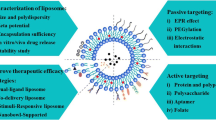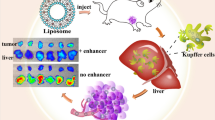ABSTRACT
Purpose
We have investigated the impact of particle size on the biodistribution, tumor uptake and antiproliferative efficacy of 5-FU-loaded liposomes.
Methods
Three different batches of pegylated liposomes varying in size (i.e., 70, 120 and 250 nm respectively) were tested. The active compounds encapsulated were an equimolar mix of 5-FU, 2′-deoxyinosine and folinic acid. Liposomes were subsequently tested on the human breast cancer model MDA231 cells, a model previously found to be resistant to 5-FU. In vitro, antiproliferative efficacy and microscopy studies of liposomes uptake were carried out. In vivo, comparative biodistribution and efficacy studies were performed in tumor-bearing mice.
Results
Difference in size did not change in vitro antiproliferative activity. Fluorescence-Microscopy studies showed that liposomes were mainly uptaken by tumor cells through a direct internalization process, regardless of their size. Biodistribution profiles in tumor-bearing mice revealed higher accumulation of small liposomes in tumors throughout time as compared with normal and large liposomes (p < 0.05). Additionally, we observed that the bigger were the tumors, the more vascularised they were and the greater was the difference in accumulation between small and large liposomes. Consequently, in vivo efficacy studies showed at study conclusion that a 68% reduction in tumor size was achieved with small liposomes (p < 0.05), whereas larger liposomes failed to reduce significantly tumor growth. Similarly, at study conclusion a trend towards higher survival-rate in animals treated with smaller liposomes was observed.
Conclusion
This study suggests that particle size is critical to achieve higher selectivity and efficacy in experimental oncology, including in resistant tumors.





Similar content being viewed by others
REFERENCES
Jain RK. Delivery of molecular medicine to solid tumors: lessons from in vivo imaging of gene expression and function. J Control Release. 2001;74(1–3):7–25.
Allen TM, Cullis PR. Drug delivery systems: entering the mainstream. Science. 2004;303(5665):1818–22.
Petros RA, DeSimone JM. Strategies in the design of nanoparticles for therapeutic applications. Nat Rev Drug Discov. 2010;9(8):615–27.
Peer D, Karp JM, Hong S, Farokhzad OC, Margalit R, Langer R. Nanocarriers as an emerging platform for cancer therapy. Nat Nanotechnol. 2007;2(12):751–60.
Torchilin VP. Recent advances with liposomes as pharmaceutical carriers. Nat Rev Drug Discov. 2005;4:145–60.
Hirsjärvi S, Passirani C, Benoit JP. Passive and active tumour targeting with nanocarriers. Curr Drug Discov Technol. 2011;8(3):188–96.
Couvreur P. Nanoparticles in drug delivery: past, present and future. Adv Drug Deliv Rev. 2013;65(1):21–3.
Taurin S, Nehoff H, Greish K. Anticancer nanomedicine and tumor vascular permeability; where is the missing link? J Control Release. 2012;164(3):265–75.
Allen TM, Cheng WW, Hare JI, Laginha KM. Pharmacokinetics and pharmacodynamics of lipidic nano-particles in cancer. Anticancer Agents Med Chem. 2006;6(6):513–23.
Li SD, Huang L. Pharmacokinetics and biodistribution of nanoparticles. Mol Pharm. 2008;5(4):496–504.
Ciccolini J, Cuq P, Evrard A, Giacometti S, Pelegrin A, Aubert C, et al. Combination of thymidine phosphorylase gene transfer and deoxyinosine treatment greatly enhances 5-fluorouracil antitumor activity in vitro and in vivo. Mol Cancer Ther. 2001;1(2):133–9.
Ciccolini J, Peillard L, Evrard A, Cuq P, Aubert C, Pelegrin A, et al. Enhanced antitumor activity of 5-fluorouracil in combination with 2′-deoxyinosine in human colorectal cell lines and human colon tumor xenografts. Clin Cancer Res. 2000;6(4):1529–35.
Fanciullino R, Mollard S, Giacometti S, Berda-Haddad Y, Chefrour M, Aubert C, et al. In vitro and in vivo evaluation of lipofufol, a new triple stealth liposomal formulation of modulated 5-fu: impact on efficacy and toxicity. Pharm Res. 2013;30(5):1281–90.
Ishikawa T, Sekiguchi F, Fukase Y, Sawada N, Ishitsuka H. Positive correlation between the efficacy of capecitabine and doxifluridine and the ratio of thymidine phosphorylase to dihydropyrimidine dehydrogenase activities in tumors in human cancer xenografts. Cancer Res. 1998;58(4):685–90.
Parhi P, Mohanty C, Sahoo SK. Nanotechnology-based combinational drug delivery: an emerging approach for cancer therapy. Drug Discov Today. 2012;17(17–18):1044–52.
Alley MC, Scudiero DA, Monks A, Hursey ML, Czerwinski MJ, Fine DL, et al. Feasability of drug screening with panels of human tumor cell lines using a microculture tetrazolium assay. Cancer Res. 1988;48(3):589–601.
Fanciullino R, Giacometti S, Mercier C, Aubert C, Blanquicett C, Piccerelle P, et al. In vitro and in vivo reversal of resistance to 5-fluorouracil in colorectal cancer cells with a novel stealth double-liposomal formulation. Br J Cancer. 2007;97(7):919–26.
Moghini SM. Long-circulating and target-specific nanoparticles, theory to practice. Pharmacol Rev. 2001;53(2):283–318.
Torchilin VP. Passive and active drug targeting: drug delivery to tumors as an example. Handb Exp Pharmacol. 2010;197:3–53.
Maeda H. Enhanced permeability and retention (EPR) effect: basis for drug targeting to tumors. In: Muzykantov V, Torchilin VP, editors. Biomedical aspects of drug targeting. Dordrecht: Kluwer; 2003.
Maeda H. The enhanced permeability and retention (EPR) effect in tumor vasculature, the key role of tumor-selective macromolecular drug targeting. Adv Enzym Regul. 2001;41:189–207.
Dams ET, Laverman P, Oyen WJ, Storm G, Scherphof GL, van Der Meer JW, et al. Accelerated blood clearance and altered biodistribution of repeated injections of sterically stabilized liposomes. J Pharmacol Exp Ther. 2000;292(3):1071–9.
Perche F, Torchilin VP. Recent trends in multifunctional liposomal nanocarriers for enhanced tumor targeting. J Drug Deliv. 2013;2013:705265.
Litzinger DC, Buiting AM, van Rooijen N, Huang L. Effect of liposome size on the circulation time and intraorgan distribution of amphipathic poly(ethylene glycol)-containing liposomes. Biochim Biophys Acta. 1994;1190(1):99–107.
Takara K, Hatakeyama H, Kibria G, Ohga N, Hida K, Harashima H. Size-controlled, dual-ligand modified liposomes that target the tumor vasculature show promise for use in drug-resistant cancer therapy. J Control Release. 2012;162(1):225–32.
Fanciullino R, Ciccolini J, Milano G. Challenges, expectations and limits for nanoparticles-based therapeutics in cancer: a focus on nano-albumin-bound drugs. Crit Rev Oncol Hematol. 2013;88(3):504–13.
ACKNOWLEDGMENTS AND DISCLOSURES
This study was supported by grants from the Association pour la Recherche contre le Cancer (ARC) and the GEFLUC Marseille Provence.
Author information
Authors and Affiliations
Corresponding author
Rights and permissions
About this article
Cite this article
Fanciullino, R., Mollard, S., Correard, F. et al. Biodistribution, Tumor Uptake and Efficacy of 5-FU-Loaded Liposomes: Why Size Matters. Pharm Res 31, 2677–2684 (2014). https://doi.org/10.1007/s11095-014-1364-9
Received:
Accepted:
Published:
Issue Date:
DOI: https://doi.org/10.1007/s11095-014-1364-9




